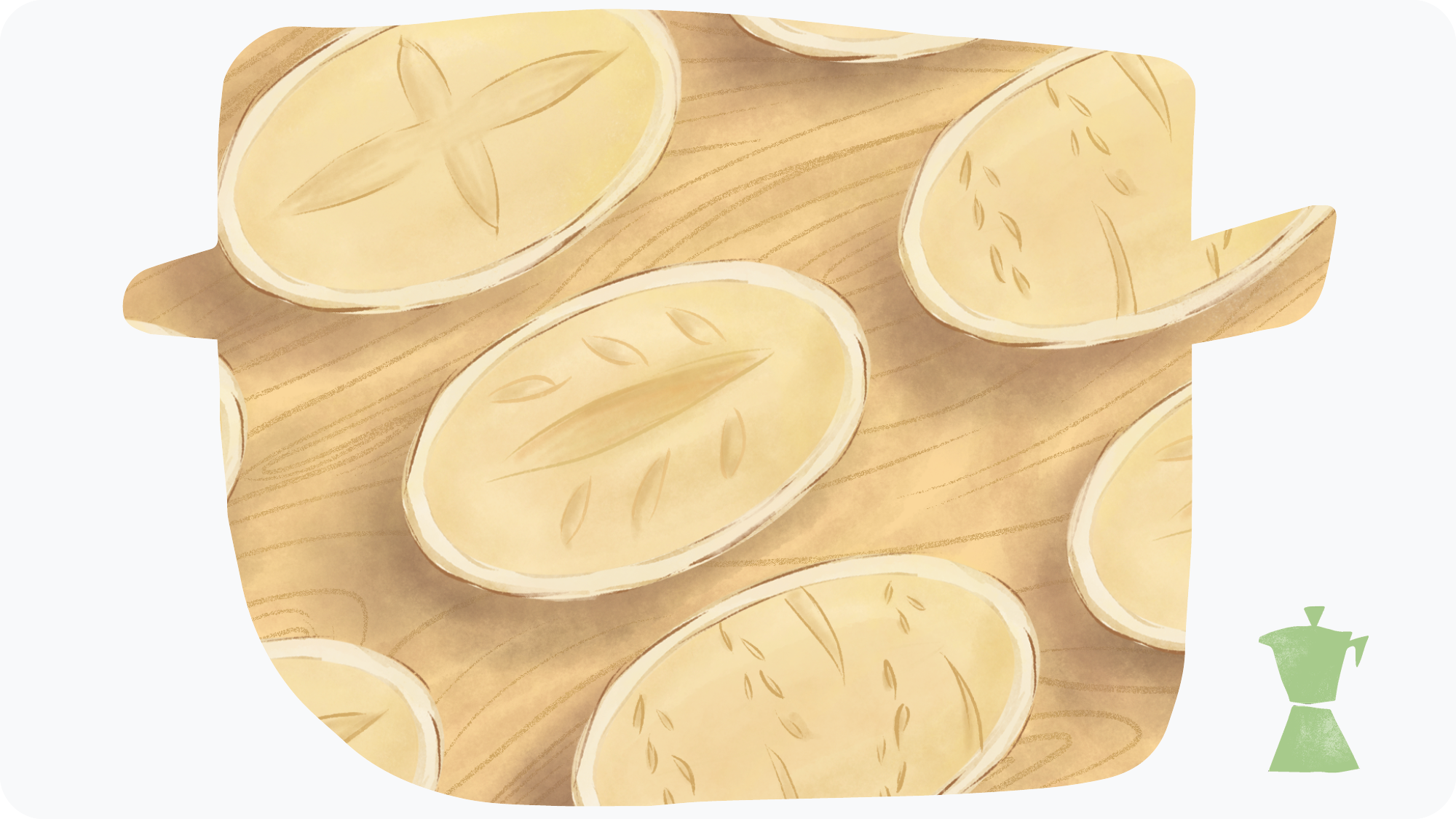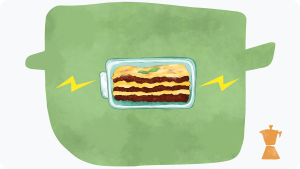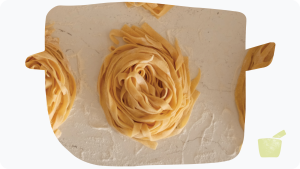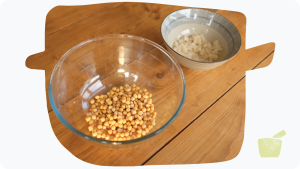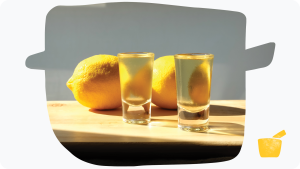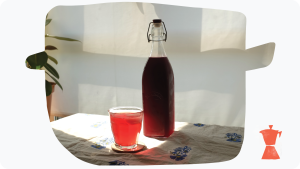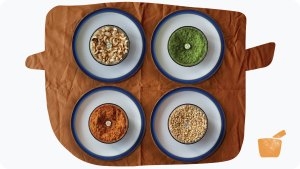There are many places to find a purpose; here’s how I discovered mine at the bottom of a gastronorm.
The difference between cooking in a restaurant and cooking at home is, unsurprisingly, vast. Everything is ordered, prepped and cooked on a titanic scale. I thought chefs were muscly for aesthetic reasons: I was wrong.
One of the first things the chef teaches me to make is sourdough bread. But we aren’t just making one loaf, we are making twelve, and we do this every day.
Elbows deep in dough
He stands over a gastronorm perched precariously on a set of scales, watery levain (essentially, some sourdough starter given a good feeding of flour and mixed with water) sloshing from side to side. At his instruction, I hurry back and forth to the enormous flour bin, heaping almost a kilogram of flour into the water. Hitching up his sleeves, he attacks it with his strong, scarred, baker’s hands. “Always use your hands for bread,” he says. “Yes, there are machines that will do it quicker, but you’ll never really learn about dough unless you do it like this.”
He begins by swirling the flour into the water with his hands, spread like claws, creating dusty whorls over its clear surface, until all that remains is a sticky beige slurry. He then starts to attack the pockets of dry flour hiding in the soup, which gets stiffer and stiffer as the flour and water become one.
I look on from the side, watching as his jaw tightens in concentration and a pink tide creeps up his cheeks with the effort of integrating flour and water. When he lifts out his hands, they have grown to the size of bear claws, coated in a mixture which is both scraggy and sticky. A dough scraper is enlisted to scrape it off, elastic strands already becoming apparent as the gluten in the flour begins to activate. Chef wipes the sweat off his brow. We leave it for half an hour, to sit. I feel like sitting too, and I haven’t even done anything.
Panning for gold
Next is financiers. I don’t know what these are – but given that we are in the pastry section, immediately imagine something like a sugar mouse, except shaped like a banker.
Obviously not. A financier, it turns out, is so-called because it is traditionally baked in a trapezoidal mould which makes each cake resemble a gold ingot. Perfect to serve as petit-fours with the bill (often to the other sort of financiers, in fact).
Petit-fours, by the way, literally means “small oven”, owing to the fact that these little after-pudding treats were traditionally cooked in, well, a smaller oven. They may be small, but the process of making them transpires to make an ungodly amount of mess.
We start off by browning butter – to make beurre noisette. When butter melts, the milk solids (the white sediment at the bottom of the pan, and the most flavoursome part of the butter) separates from the golden liquid fat (this, by the way, is clarified butter, used for cooking things at a very high heat). The idea is to cook the milk solids to a gorgeous, chestnut brown colour, until the butter releases the most heavenly aroma – sweet, salty and caramel all at the same time.
Again, doing everything in Herculean proportions, we start off by browning 1.2 kilograms. Next time you buy a pack of Kerrygold, check the weight, and then have a good think about how much butter that is.
I heave the biggest saucepan I can find over to my station and start dicing butter. It quickly becomes warm and greasy and sticks to my enormous chef’s knife, and it takes real concentration to avoid amputating a finger in the process. I place it on the hotplate in the grill section and then return to my station to start the next part of the recipe: making a French meringue.
Losing myself in the mixture
Dough may be a “hands-only” job, but this task, I am relieved to hear, can be achieved using a stand mixer – although it will have to be conducted in two batches due to the volume of meringue that will be created by whisking egg and sugar at high speed. For most kitchen jobs, whites and yolks come from giant cartons, not eggs. This is both for ease, and due to the fact that both have been pasteurised, minimising the risk of germs, food poisoning and reputational damage.
I have made meringue in a stand mixer a few times before at cooking school, but still find it mesmerising to watch what happens to a scoop of sugar sitting in a translucent pool of albumen when air is whisked into it. The end result is so eerily perfect – ice-white ripples of glossy silk – that they seem to have come from a lab, surely nothing natural can result in this. I stare at the mousse, mushrooming with every rotation of the whisk, and a memory of a Barbara Hepworth sculpture floats into my mind, dazzling white and fluidly curved.
An angry sizzling, hissing sound interrupts my reverie and the image disappears. I am back in the kitchen, the whir of the whisk loud in my ears, the mingled smell of food and detergent from the pot washing station next to me – and on top of that, the aroma of something browning, blackening, burning…
I turn off the stand mixer and scurry over to the hotplate. My kilogram of butter has melted alright, and is spewing an angry, fizzing froth over the top of the pan like Mount Vesuvius about to asphyxiate Pompei. The very French senior sous-chef swoops in out of nowhere like a bat, tea towel wrapped around his hand. He swiftly removes the saucepan from the hotplate, where the overflow has already burned into blackened nothingness. He plonks it on the side and we both peer down into the pan, waiting for the bubbles to subside. Mercifully, it looks as if it’ll be alright. I open my mouth to say I’m sorry but before I can, he is walking away, muttering “Well, zat is one way to brown butter.”
The butter, meringue and dry ingredients – gluten free flour, ground hazelnuts and cocoa powder – are integrated and apportioned into piping bags. They go into the refrigerator to stiffen before we pipe them into 120 individual silicon moulds later in the day.
Back to bread
Half an hour is up, and it is time to check on our bread. “Why do we put salt in bread?” asks the chef, holding a nine-pan full of the stuff aloft over the gastronorm. “Flavour…?” I tentatively offer. I have become so used to putting salt in everything since cooking school, I am now only really aware of examples of when not to put salt in something.
“Yes,” he says, “And for texture. And for colour.” I rack my brains, flicking through my cooking school memories, trying to remember why this is. My puzzlement obviously shows, and chef asks, “Why do we put the salt in now, not at the beginning?” Because salt kills yeast, I say.
“Right, so we don’t want the yeast to die. But we don’t want them to go crazy either. Or they’ll eat up all the sugar in the bread. Then, when it goes in the oven, there’ll be nothing in the bread to caramelise into a nice dark crust, see?” He reaches up and grabs one of yesterday’s loaves – to be used for the Cornish mussels – off the shelf, and runs a finger over the shiny, burnished bronze crust. I nod.
“And salt makes gluten stronger, which is what makes it chewy.” I watch as he scatters salt across the surface of the dough and begins to scrunch it in with his hands. This does all sound familiar. He moves to the side and gestures to the tray. “This is your last opportunity to mix,” he warns, “so make sure it’s all integrated.”
I plunge my hands into the soft, cool dough and feel the slight abrasiveness of salt under my hand, and begin to scrunch as instructed. I lean against the counter, hunch my shoulders up around my neck and put my whole body weight into it, working the salt into the dough like I am giving it the massage of its life. Chef watches from the side-lines, nodding in approval as I scrunch away, arms buried in dough, sweat dribbling down my neck.
I have only ever made individual loaves, and there is something so satisfying about grappling with such a mammoth quantity of ingredients, knowing that it is going to result in so much nourishment, that it will feed so many people.
On arrival, each party is greeted with a gloriously warm plate of slices (one more than every diner, for added largesse) and a ramekin of new season olive oil. During service, as I frantically try to juggle starters, dessert and petit fours, I somehow find the time to appreciate our handiwork, pausing to admire the air bubbles, the dark brown crust – slightly sweet, sour and bitter all at the same time.
What’s it all for?
Somehow, and I still can’t really explain why, processes make sense to me when completed on a larger scale, in a way they didn’t at cooking school. I remember sitting in lectures, learning about breadmaking, waking up at the crack of dawn to bake my own loaf of bread in the mornings at Ballymaloe, to take home and share with my cottage.
I remember carrying around a tub of dough, enough for a single loaf, and stretching and folding it at half an hour intervals. Remember resting it, and shaping it and tightening it. But I don’t think the science of it ever really made sense to me until now, when I completed it on such a massive scale, exerting all my effort as I heaved up one end of the dough and pulled it over the other, tucking it in and twisting the gastronorm 90 degrees in order to repeat the process on the other side. Or until I stood there, over twelve rounds of dough waiting to be shaped and placed in bannetons.
I suppose there could be many reasons why it began to click. It could be sheer repetition, or using existing skills in a new context. I wonder too, if it was something to do with the fact that, by the end of the process, I had twelve pieces of evidence – rather than just one – to show that the process did work, could work, would work, over and over again if I followed the recipe. If twelve of them came out perfect, it couldn’t just be a fluke.
I think more likely, however, is that things become more meaningful when you are doing them for a purpose, and that purpose is to feed and nourish and delight others. The process is not being learnt for its own sake, it is being followed in order that, when a patron enters the restaurant, they will be greeted with something they didn’t ask for: a warm slice of hard work and chemistry that says, “you are very welcome, we are glad to have you.”
Then, when the meal is over, the glasses empty and the bill arrives, it is ever so slightly sweetened by a sugar dusted ingot, which in turn thanks you for coming, and sends you onward into the night.
